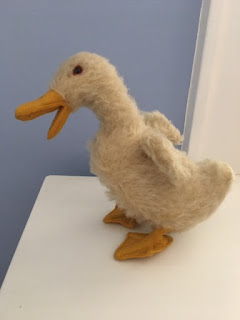 What collector would not want to feather their nest with this dapper duck? This toy is officially named "Play Duck." He is standing, 22 cm tall, unjointed, and stuffed with excelsior. Play Duck is made from yellow wool plush fabric. His beak and feet are dimensional and are made from matching yellow felt. His feet are lined in wire and are posable. His two small wings are spread out playfully along his back. Play Duck's eyes are made from black buttons and are backed in red felt circles - a design feature often seen on Steiff's birds. He has a nonworking squeaker in his torso. He retains his short trailing "f" style Steiff button in his wing as his ID. Play Duck was made in this size only from 1933 through 1943.
What collector would not want to feather their nest with this dapper duck? This toy is officially named "Play Duck." He is standing, 22 cm tall, unjointed, and stuffed with excelsior. Play Duck is made from yellow wool plush fabric. His beak and feet are dimensional and are made from matching yellow felt. His feet are lined in wire and are posable. His two small wings are spread out playfully along his back. Play Duck's eyes are made from black buttons and are backed in red felt circles - a design feature often seen on Steiff's birds. He has a nonworking squeaker in his torso. He retains his short trailing "f" style Steiff button in his wing as his ID. Play Duck was made in this size only from 1933 through 1943. It's hard not to notice Play Duck's interesting material. Wool plush is a lovely toy making fabric as it is durable, high quality, and gives items a charming, old fashioned look. It has a "fuzzy" feeling to it, and even though it is also produced on a cotton backing like mohair, its fibers are more "continuous" than mohair fibers, which tend to be a little more "prickly" and distinctive. Steiff often used wool plush as a substitute fabric in the place of mohair for a few years before and a few years after World War II, when the company's more traditional mohair and felt fabrics were sanctioned or not available at all. When you see a vintage Steiff item made from wool plush, there's a really good chance that it was made in the 1930's through early 1950's time frame.
It's hard not to notice Play Duck's interesting material. Wool plush is a lovely toy making fabric as it is durable, high quality, and gives items a charming, old fashioned look. It has a "fuzzy" feeling to it, and even though it is also produced on a cotton backing like mohair, its fibers are more "continuous" than mohair fibers, which tend to be a little more "prickly" and distinctive. Steiff often used wool plush as a substitute fabric in the place of mohair for a few years before and a few years after World War II, when the company's more traditional mohair and felt fabrics were sanctioned or not available at all. When you see a vintage Steiff item made from wool plush, there's a really good chance that it was made in the 1930's through early 1950's time frame.Play Duck's felt features are also quite charming, and give him a toddler-esque look.
 First... his tootsies. His somewhat oversized feet are actually webbed, like a real duck, and allow him to stand and balance easily. His "toes" are formed by the stitching on his feet.
First... his tootsies. His somewhat oversized feet are actually webbed, like a real duck, and allow him to stand and balance easily. His "toes" are formed by the stitching on his feet.  Second... his beak. His two part, open beak is positioned in such a way that he appears to be smiling. It is detailed with two small grey marks on the top, indicating his nostrils. Most prewar Steiff ducks either have closed dimensional beaks, or simpler beaks made from orange single or double thick flat felt. As such, this is one lucky ducky! Remarkably, both Play Duck's feet and his beak are stuffed with excelsior. Just imagine the precision, time, and skill required to do that!
Second... his beak. His two part, open beak is positioned in such a way that he appears to be smiling. It is detailed with two small grey marks on the top, indicating his nostrils. Most prewar Steiff ducks either have closed dimensional beaks, or simpler beaks made from orange single or double thick flat felt. As such, this is one lucky ducky! Remarkably, both Play Duck's feet and his beak are stuffed with excelsior. Just imagine the precision, time, and skill required to do that!Steiffgal hopes this discussion on her new fine feathered friend had all its ducks in a row.
Have a question about one of your Steiff treasures? Let's talk! Click here to learn more.






